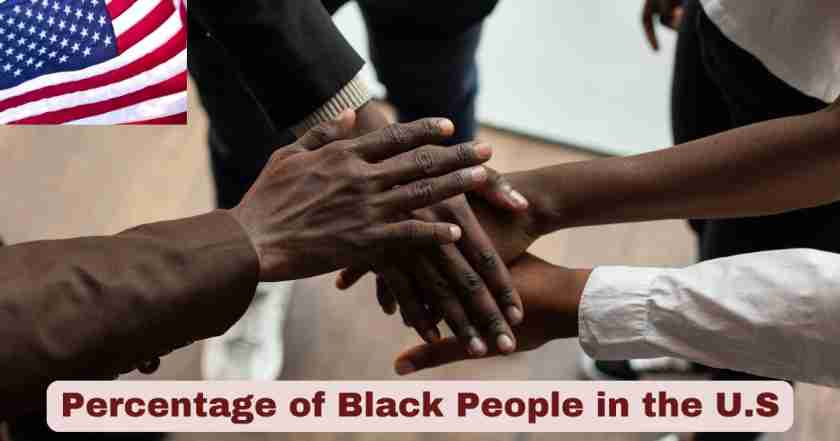Percentage of Black People in the US 2025
The Black or African American population continues to represent a significant and growing demographic in the United States, with recent government data showing substantial changes in both population size and percentage representation. As we examine the most current statistics for 2025, the percentage of Black people in America reflects not only natural population growth but also increased diversity in racial identification patterns across the nation.
Understanding these demographic trends is crucial for policymakers, researchers, and community leaders who work to address the needs of this vital population segment. The latest Census Bureau data provides comprehensive insights into how the Black American population has evolved, including both those who identify as Black alone and those who identify as Black in combination with other races, revealing a more complex picture of racial identity in modern America.
Facts & Stats About Black Population in the US 2025
| Demographic Fact | 2025 Statistics |
|---|---|
| Total Black Population | 48.3 million people |
| Black Population Percentage | 14.4% of total US population |
| Black Alone Population | 43.1 million people |
| Black in Combination Population | 49.5 million people |
| Population Growth Since 2000 | 33% increase |
| Black Alone or in Combination | 14.9% of total population |
| Multiracial Black Population Growth | 88.7% increase since 2010 |
| Black Alone Population Growth | 5.6% increase since 2010 |
As of 2025, the Black population in the United States has reached a total of 48.3 million people, accounting for 14.4% of the total U.S. population. This figure includes individuals who identify as Black alone—a category comprising 43.1 million people—as well as those who identify as Black in combination with another race, bringing that expanded figure to 49.5 million. The U.S. Census Bureau reports that the population identifying as Black alone or in combination now represents 14.9% of the total U.S. population. This broader classification reflects the increasing racial and ethnic diversity in the country, especially among younger generations who are more likely to report multiracial identities.
The growth of the Black population over time is particularly significant. Since the year 2000, the total Black population has grown by 33%, driven by both natural growth and increased immigration. The Black multiracial segment has experienced an especially sharp rise, increasing by an extraordinary 88.7% since 2010. In contrast, the Black alone population—those who identify solely as Black—has grown at a slower pace of 5.6% over the same period. These trends highlight the evolving nature of racial self-identification in America, with more individuals embracing multiracial backgrounds. The data collectively suggests not only a steady demographic expansion but also a shift in how race and identity are expressed and recorded across the United States.
Black Population Growth Trends in the US 2025
| Growth Category | Population Change | Percentage Change |
|---|---|---|
| Black Alone Population Growth | From 36.2 million (2000) to 43.1 million (2025) | 5.6% since 2010 |
| Black in Combination Growth | Significant increase in multiracial identification | 88.7% since 2010 |
| Total Black Population Growth | 33% increase since 2000 | From 36.2 million to 48.3 million |
| Current Annual Growth Rate | Steady demographic expansion | Second largest racial group |
The growth patterns demonstrate two distinct demographic phenomena within the Black American population. While the Black or African American alone population grew 5.6% since 2010, the Black or African American in combination population grew 88.7%. This dramatic difference in growth rates reflects changing social attitudes toward multiracial identity and the increasing acceptance of complex racial backgrounds.
The steady growth has maintained the Black population’s position as the second largest racial group in the United States, with Black or African Americans are second largest race in United States, with 12.36% of the total population. This demographic stability underscores the continued importance of understanding and addressing the needs, challenges, and contributions of Black Americans across all sectors of society.
Regional Distribution of Black Population in the US 2025
| Regional Concentration | Key Statistics |
|---|---|
| Southern States | Highest concentration of Black Americans |
| Urban Areas | Majority of Black population in metropolitan areas |
| State Variations | Significant differences in Black population percentages |
| Migration Patterns | Continued movement within and between regions |
The regional distribution of the Black population continues to reflect historical patterns while showing evidence of new migration trends. Traditional centers of Black population in the South maintain their significance, while urban areas across the country continue to attract and retain substantial Black populations. Understanding these geographic concentrations is essential for resource allocation, political representation, and community development initiatives.
Population density varies significantly across states, with some states having Black populations that represent over 25% of their total population, while others have much smaller percentages. These variations influence everything from electoral politics to business development and cultural programming, making regional analysis crucial for anyone working with or within Black communities.
Economic & Social Indicators for Black Americans in the US 2025
| Economic Indicator | Current Status |
|---|---|
| Median Household Income | Continues to show progress with ongoing gaps |
| Educational Attainment | Increasing college graduation rates |
| Business Ownership | Growing entrepreneurship trends |
| Homeownership Rates | Gradual improvement in property ownership |
The economic landscape for Black Americans shows both significant progress and persistent challenges. Educational attainment continues to rise, with more Black Americans than ever before earning college degrees and pursuing advanced education. This educational progress translates into expanded career opportunities and increased economic mobility for many families.
Business ownership among Black Americans has shown notable growth, with entrepreneurship becoming an increasingly important pathway to economic advancement. The rise in Black-owned businesses spans various sectors, from technology startups to traditional service industries, contributing to both community wealth building and overall economic diversity. These trends reflect both increased access to capital and resources, as well as the entrepreneurial spirit that has long characterized Black American communities.
Future Projections for Black Population in the US 2025
| Projection Category | Expected Trends |
|---|---|
| Population Growth | Continued steady increase |
| Multiracial Identity | Accelerating growth in combination categories |
| Geographic Distribution | Potential shifts in regional concentrations |
| Age Demographics | Younger average age compared to overall population |
Looking ahead, demographic experts anticipate continued growth in the Black American population, with particularly strong expansion in the multiracial category. This trend reflects broader social changes in how Americans think about and identify their racial heritage, with younger generations more likely to embrace multiple racial identities.
The age structure of the Black population, which skews younger than the overall U.S. population, suggests continued growth momentum and significant implications for future educational, economic, and social policies. This demographic advantage positions Black Americans to play an increasingly important role in the nation’s workforce and civic life, making current investment in education, economic opportunity, and community development particularly crucial for the nation’s overall prosperity and social cohesion.
Disclaimer: The data research report we present here is based on information found from various sources. We are not liable for any financial loss, errors, or damages of any kind that may result from the use of the information herein. We acknowledge that though we try to report accurately, we cannot verify the absolute facts of everything that has been represented.







